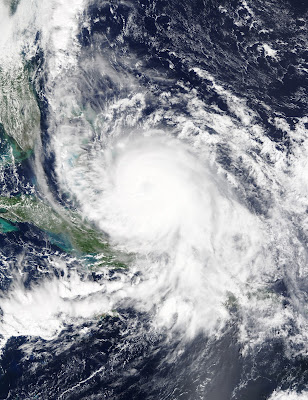12 cyclones attaining tropical depression status,
11 cyclones attaining tropical storm status,
4 cyclones attaining hurricane status, and
2 cyclones attaining major hurricane status.
Before the beginning of the season, I predicted that there would be
9 cyclones attaining tropical depression status,
7 cyclones attaining tropical storm status,
3 cyclones attaining hurricane status, and
1 cyclone attaining major hurricane status.
The season was in fact slightly below average, since the average numbers of tropical storms, hurricanes, and major hurricanes are 12.1, 6.4, and 2.7, respectively. However, the actual totals exceeded my predictions in all categories. Nonetheless, a majority of the cyclones that did form were short-lived, a fact which is quantitatively confirmed by the low value of the Accumulated Cyclone Energy. This value, which was 59 for the 2015 season, takes into account both the intensity and longevity of each storm. 59 is only 67% of the thirty year median and is lower than that of the 2014 season, though it featured a smaller number of cyclones.
The greatest influence on cyclone development of the 2015 season was the strong El Nino event. Indicated by anomalously warm ocean temperatures over the equatorial East Pacific region, this event began in 2014 but strengthened significantly through 2015, becoming one of the three strongest events in recorded history and at least the strongest since 1997-8. As a result, strong upper-level winds prevailed across the Caribbean sea and Gulf of Mexico (as well as other parts of the tropical Atlantic). Notably, no tropical storms formed in the Caribbean during the season, and the two that entered it, Danny and Erika, were torn apart by wind shear shortly after doing so.
In contrast, high sea surface temperatures supported tropical cyclone formation. The above map, showing global temperature anomalies during September 2015 (the heart of hurricane season) show a band of record warm ocean temperatures over the subtropics, extending from the Bahamas and southeastern U.S. coast eastward. This band supported the formation of Hurricane Joaquin toward the end of September and early October, which became the strongest storm of the season with 155 mph winds and a minimum pressure of 931 mb. Record sea temperatures fueled this system in spite of the El Nino; the comparable El Nino events of 1997, 1982, and 1972 had no hurricanes even close to this strength. The season included a few tropical storm landfalls in the United States, but Joaquin's impact on the Bahamas was by far the most devastating.
Some other notable facts and statistics concerning this season include:
- Tropical Storm Ana made the second-earliest U.S. landfall in the Carolinas on May 10, behind only the unusual Groundhog Day storm of 1952
- Hurricane Fred was named at 18.9° W, one of only 4 storms to be named this far east; it also was the first storm in a century to affect the Cape Verde Islands as a hurricane
- Hurricane Joaquin was the strongest cyclone in the Atlantic basin since Igor of 2010
Overall, the season was quiet, with Joaquin as the only notable cyclone in terms of intensity and damage.
Sources: http://www.vox.com/2015/8/17/9164499/el-nino-2015, http://www.ncdc.noaa.gov/sotc/























.jpg)
%2BTrack.png)














